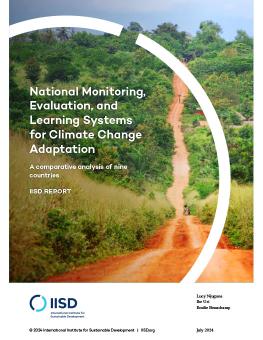
National Monitoring, Evaluation, and Learning Systems for Climate Change Adaptation
A comparative analysis of nine countries
This report explores how nine countries are advancing climate adaptation through innovative monitoring, evaluation, and learning (MEL) systems. This report compares the unique approaches of Canada, France, Kenya, Namibia, Peru, Somalia, Tonga, the United Kingdom, and Vietnam, shedding light on their progress, challenges, and the integration of gender equality and social inclusion (GESI) considerations.
-
Countries have made significant progress on their MEL for #adaptation since 2014! Countries like Kenya have established legal frameworks for MEL, while Canada, Somalia, and Namibia have strengthened systematic approaches through their NAP processes.
-
Gender equality and social inclusion are critical for effective climate #adaptation. But our latest report shows that integrating GESI into national MEL systems is lacking.
-
Our report highlights the critical links between national MEL systems and global UNFCCC processes, including the UAE Framework for Global Climate Resilience. These connections are vital for coherent global #adaptation action.
This study provides an analysis of national MEL systems for adaptation across nine countries: Canada, France, Kenya, Namibia, Peru, Somalia, Tonga, the United Kingdom, and Vietnam. The report highlights the unique approaches each country takes in designing and implementing their MEL systems, reflecting their distinct economic, governance, and environmental contexts.
Since 2014, significant strides have been made, with more countries integrating MEL into their national adaptation plans (NAPs). The study showcases how nations like Kenya have developed legal frameworks to guide MEL, while Canada, Somalia, and Namibia have reinforced systematic approaches through their NAP processes. Despite these advancements, the report identifies ongoing challenges, particularly in the areas of evaluation and learning activities, which are less prominent than monitoring efforts.
While monitoring and reporting activities are prevalent, evaluation and learning activities remain less prominent under current MEL systems. Nonetheless, nearly half of the countries reviewed have produced monitoring progress reports or evaluations that have informed subsequent policy cycles.
The integration of GESI considerations is another critical focus, with Kenya and Vietnam setting examples by incorporating specific GESI indicators. However, the systematic integration of GESI considerations remains insufficient. The study emphasizes the necessity of a tailored, context-specific approach to developing effective MEL systems, emphasizing the iterative nature of these processes.
The report provides valuable insights and recommendations for policy-makers, adaptation practitioners, and MEL specialists, highlighting the importance of continuous learning from MEL systems in supporting climate resilience. Additionally, it explores the critical links between national MEL systems and global United Nations Framework Convention on Climate Change processes, including the UAE Framework for Global Climate Resilience.
By exploring diverse national experiences, the study can inform governments working to strengthen their national MEL systems and contribute critical data to global reporting and assessment processes.
You might also be interested in
Toolkit for Monitoring, Evaluation, and Learning for National Adaptation Plan Processes
This toolkit provides practical guidance for the development and continuous improvement of MEL systems for national adaptation plan processes to government teams and practitioners working on adaptation.
Climate Risk Profile—Fiji
This climate risk profile provides an overview of the Fiji's climate context, observed and projected climate change impacts, and a set of recommended NbS for adaptation actions and measures to promote gender-responsive and socially inclusive climate adaptation.
How Indigenous Negotiators Fared in 2024
In the foreword in The State of Global Environmental Governance 2024, Hindou Oumarou Ibrahim shares her insights on what goals were reached, where "business as usual" must change, and what her priorities are for 2025.
Advancing Gender-Responsive and Socially Inclusive Practices in Nature-Based Solutions for Adaptation
Get inspired by two nature-based solutions for climate adaptation projects that integrate gender equality and social inclusion considerations at various stages of implementation.